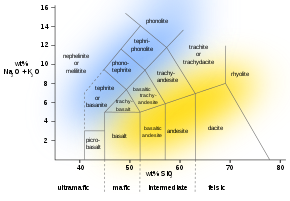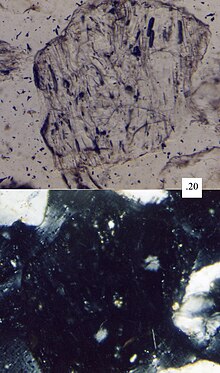




Aphanites (adj. aphanitic; from Ancient Greek αφανης (aphanḗs) 'invisible') are igneous rocks that are so fine-grained that their component mineral crystals are not visible to the naked eye[2] (in contrast to phanerites, in which the crystals are visible to the unaided eye). This geological texture results from rapid cooling in volcanicorhypabyssal (shallow subsurface) environments. As a rule, the texture of these rocks is not the same as that of volcanic glass (e.g., obsidian), with volcanic glass being non-crystalline (amorphous), and having a glass-like appearance.[3]
Aphanites are commonly porphyritic, having large crystals embedded in the fine groundmass, or matrix. The larger inclusions are called phenocrysts. They consist essentially of very small crystals of minerals such as plagioclase feldspar, with hornblendeoraugite, and may contain also biotite, quartz, and orthoclase.[2]
This igneous rock-related article is a stub. You can help Wikipedia by expanding it. |